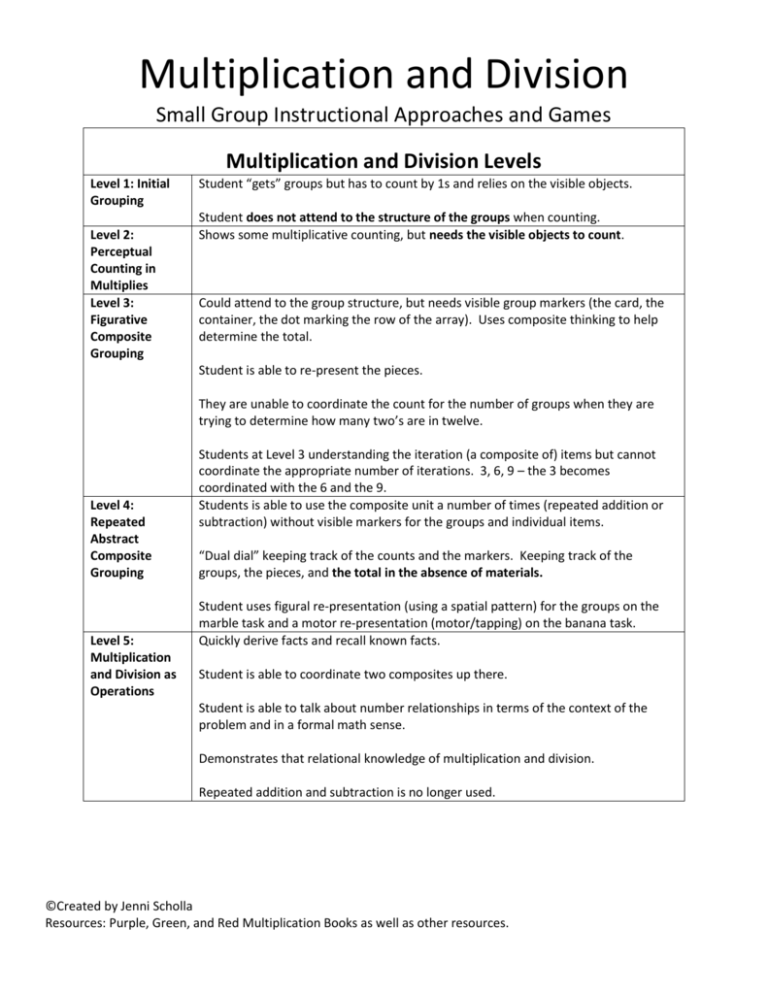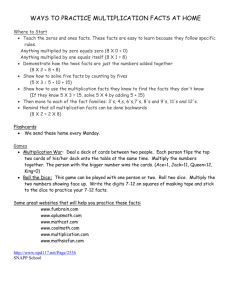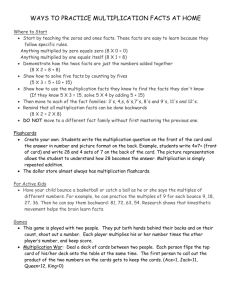Multiplication and Division Levels
advertisement

Multiplication and Division Small Group Instructional Approaches and Games Multiplication and Division Levels Level 1: Initial Grouping Level 2: Perceptual Counting in Multiplies Level 3: Figurative Composite Grouping Student “gets” groups but has to count by 1s and relies on the visible objects. Student does not attend to the structure of the groups when counting. Shows some multiplicative counting, but needs the visible objects to count. Could attend to the group structure, but needs visible group markers (the card, the container, the dot marking the row of the array). Uses composite thinking to help determine the total. Student is able to re-present the pieces. They are unable to coordinate the count for the number of groups when they are trying to determine how many two’s are in twelve. Level 4: Repeated Abstract Composite Grouping Level 5: Multiplication and Division as Operations Students at Level 3 understanding the iteration (a composite of) items but cannot coordinate the appropriate number of iterations. 3, 6, 9 – the 3 becomes coordinated with the 6 and the 9. Students is able to use the composite unit a number of times (repeated addition or subtraction) without visible markers for the groups and individual items. “Dual dial” keeping track of the counts and the markers. Keeping track of the groups, the pieces, and the total in the absence of materials. Student uses figural re-presentation (using a spatial pattern) for the groups on the marble task and a motor re-presentation (motor/tapping) on the banana task. Quickly derive facts and recall known facts. Student is able to coordinate two composites up there. Student is able to talk about number relationships in terms of the context of the problem and in a formal math sense. Demonstrates that relational knowledge of multiplication and division. Repeated addition and subtraction is no longer used. ©Created by Jenni Scholla Resources: Purple, Green, and Red Multiplication Books as well as other resources. Construct 0-1 Goal: multiplication as a process; equal groupings Helps students who… FNWS and BWNS Need fluency with skipby multiples counts Things In Groups 0 Grouping Items 0 Materials Needed: Notes: Numeral Track (see later These students probably are not for more ideas) attaching a lot of quantity to the verbal sequence, but it’s something SMART Board or Small you can continually work on. When Group working with small groups, add the dot strips to help add the quantity. Make lists of things that come in 2s, 3s, 4s, and so on. Draw their attention to “groups” of things. Create lists. Any manipulative Provide many opportunities of students to group items. “here are 16 counters. How can we group them equally? Other questions: How many legs at your table? How many eyes for these 4 people? Etc. ©Created by Jenni Scholla Resources: Purple, Green, and Red Multiplication Books as well as other resources. Construct 1-2 Goal: lead to multiplicative counting for visible and screened items. Activity A Lemonade Stand Helps students who... Direct modelers Constructs 0-2 Materials Needed: Rolling Groups Direct Modelers p. 16-19 in AVMR Constructs 0-2 Book 2 Teacher’s Handbook Loops and Groups/Circles and Stars Dot Cards (strips and dice patterns) Lemonade Stand Game board cubes and cups dice Watch for strategy use: CB1 or other CB Rolling Group Game boards and Materials Rolling Groups record sheet dice Watch for strategy use: CB1 or other CB Direct Modelers Constructs 0-2 Direct Modelers who need the visual support yet Construct 2 Notes: Watch for strategy use: CB1 or other CB dice Recording sheet dot strips SMART Board dot strips and numeral track (helps see the connection between repeated addition and multiplication) Can be done whole group with SMART Board doc or small. Ask: How many cards? How many dots on each? How many all together? Vary the order of questioning. This can lead into symbolic representations with number sentences. Dot Arrays (unscreened for lower constructs, partial screens and flashed, for higher constructs) Construct 2-4(depends on the multiple being used and how much is screened) Students who visual support arrays are located on the shared folder Origo (see Jenni if interested - these are organized by strategy) Make sure to tie in both multiplication and division with these to GREAT for strategy work (i.e.doubling, building up/building down) ©Created by Jenni Scholla Resources: Purple, Green, and Red Multiplication Books as well as other resources. Helps provide a visual structure and organization before moving onto number and verbal sequences Circle and Stars/r Unscreened to Screened Loops and Groups (screened and flash MR Purple p. 163) SMART doc or you could make on paper with card/lids Be creative – birds in trees, cookies on a plate, etc. Things to watch for: How are they counting these? (starting from one, stress-counting, skip-counting) Ask: How many groups? How many in each? How many all together? Construct 3 Goal: Getting them from direct modeling to using additive subtractive strategies (repeated addition or subtraction). Working towards full screened – no visible markers (bare tasks). Construct 4 Goal: Can solve all screened task using additive subtractive strategies (repeated addition or subtraction). These students would benefit from relational tasks now. Using Multiplication Language Ideas in Class Are ten 8s the same as eight 10s. How do you know? Fluently double a number – doubling up to 100 Fluently half a number – halving numbers up to 100 How are 10 facts related to 5 facts? Using arrays to show 8 x 3 = 6 x 4 How can I use 9 x 8 to help me solve 18 x 4? (Construct 4) What non-count by strategies an I use to solve 8 x 6? (Use array model and students can find and partition out 5s, etc. How can I use 2 x 8 = 16 to solve 4 x 8? If 14 x 3 = 42, what is 15 x 3 =? Commutative Property – “flip flops” Inverse Property Multiplication Property of One Multiplication Property of Zero ©Created by Jenni Scholla Resources: Purple, Green, and Red Multiplication Books as well as other resources. Thoughts to Ponder: Strategy vs. Numeral Sequences Problem solving strategies are flexible and work efficiently in a variety of settings and extend beyond the basic facts. For example: If I know that x5 is half of x10, when presented with a problem 243 x 5, I can do 243 x 10 which is 2430 and then I can half that (half of 2000 is 1000, half of 400 is 200, half of 30 is 15) so mentally I can calculate 243 x 5 as 1, 215. Numeral Sequences are a skill, and important and useful skill worth teaching. But, when taking it out of the context of basic facts, skip counting to solve 243 x 5 is not an efficient strategy. It is important to keep in mind that there is a distinction between merely saying the sequence of multiples and the conceptual understanding of using them to count items in repeated groups. When planning instructional activities and games, be cognizant of the purpose of the activity and how it will extend beyond basic facts. Make sure a variety of instructional approaches are used and support verbal skip-counting sequence by providing visual/concrete experiences with them to help students understand the quantity. Remember: fact fluency will not really be truly be established until students have had other strategies (direct modeling and counting) Goal: Understanding multiplication as repeated addition and using multiplicative counting Class/Group Count Arounds Helps students who... All levels really – Helps them hear the verbal sequence of the multiples Numeral Track Treasure Hunt Numeral sequence fluency Trio for Multiples Purple MR Book Numeral sequence fluency (multiple before and after) Numeral sequence fluency (multiple before and after) Quick Draw AVMR Teacher Handbook Course 2 p. 14 Materials Needed Numeral tracks for desired multiple; SMART Board files or paper versions) Treasure Hunt Cards 3-4 sets of desired multiples 3-4 sets of desired multiples ©Created by Jenni Scholla Resources: Purple, Green, and Red Multiplication Books as well as other resources. Notes: Considered mixing up sets (i.e. doing one row of 2s and one row of 4s for doubling and halving; 3s and 6s; 2s, 4s, and 8s) Goal: Understanding multiplication and division as inverse operations and building fluency (as soon as students are moving to equal groups, start incorporating that relationship). Helps students who… Materials Needed Notes *You can adapt many multiplication games to also be division games by merely altering how you play. Be creative. Multiplication/Division Inverse Concentration Online Games: Division http://www.fun4thebrain.com/division.html Multiplication Spiral (good multiplication/division practice in general) Playing cards Salute Numeral or playing cards http://www.fun4thebrain.com/division.html Dice Place Markers Array Cards ©Created by Jenni Scholla Resources: Purple, Green, and Red Multiplication Books as well as other resources.







